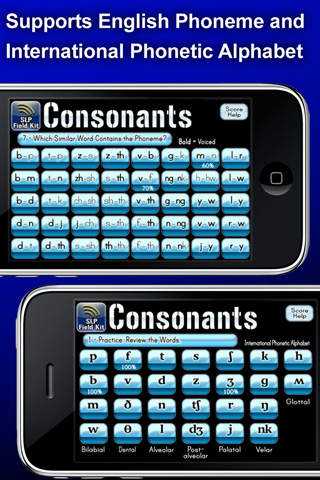
SLP Field Kit - Consonants app for iPhone and iPad
Developer: Michael Engelbrite
First release : 20 Mar 2010
App size: 13.76 Mb
SLP Field Kit is a breakthrough for speech therapy!
►SLP Field Kit aids the Speech and Language Pathologist and Speech Therapist in the field with testing and building phonemic awareness and auditory discrimination.
►Going beyond just replacing card decks and flash cards, SLP Field Kit incorporates 8 powerful, interactive activities that add dynamic training experiences that challenge and focus your clients. Traditional card decks have been difficult to sort into multi-card activities. Now, at the touch of a button, the cards are presented in powerful combinations that truly focus the client.
►In addition, SLP Field Kit incorporates phoneme buttons as part of the activities, something cards could never do.
►The recorded speech provides stability of pronunciation that promotes consistency in testing.
►361 audio word cards, which are spoken words illustrated by photographs and drawings with text (hidden when appropriate)
►8 activities to build and to test phonemic awareness
►198 lessons
►3000+ exercises
►Records scores from multiple clients and sends to email.
►Supports International Phonetic Alphabet and the English /sound/ notation
ACTIVITIES
1 PRACTICE: REVIEW THE WORDS
This activity allows an overview of the words. It displays a word card with a word containing the phoneme (with picture and text), a brief description of the phoneme, and a button showing the phoneme. Press the word card to hear the word and the phoneme button for the phoneme.
2 WHICH PHONEME IS IN THE WORD?
In this activity, phonemes are grouped in fours or twos according to their general ‘place’: bilabial, dental, alveolar, post-alveolar, palatal, velar, and glottal. After selecting a group, a word card (without text) containing one of the phonemes from the group is shown along with the phoneme buttons. Example: Which phoneme /p/, /b/, /m/, or /w/ is in the word ‘bead’? The client selects the phoneme in the word. This activity hones auditory discrimination for phonemes initiated from the same general ‘place’. (Morais, 2003)
3 WHICH WORD CONTAINS THE PHONEME?
This exercise displays two word cards (without text) and the target phoneme. Example: Which contains /b/; ‘bear’ or ‘cap’? The client must select the word card that contains the target phoneme. (van Hage 2006)
4 IS THE PHONEME AT BEGINNING, MIDDLE OR END?
This exercise shows a single word card with a phoneme button. The client selects from three buttons: ‘beginning’, ‘middle’, or ‘end’. Example: Is the sound /n/ at the beginning, middle, or end of the word ‘money’? (Post 2007)
5 CHOOSE SIMILAR WORD BY HEARING THE WORD
This exercise shows two word cards as minimal pairs, and a button with the audio target word. Example: Which card is ‘bear’(spoken)? Is it ‘bear’ or ‘pear’ (visual and spoken word cards). The client selects the word card that contains the target word. (multisensory matching, Senkowski 2009)
6 WHICH PHONEME IS IN BOTH WORDS?
In this activity, two word cards containing one common phoneme are shown. The client must choose from 4 (or 2 for /h/ and /hw/) phoneme buttons. Example: Which phoneme /p/, /b/, /m/, or /w/ is in both words bead and chubby?
7 WHICH SIMILAR WORD CONTAINS THE PHONEME?
This exercise shows two word cards as minimal pairs, and a button with the audio target phoneme. Example: Which card contains /b/; ‘bear’ or ‘pear’? The client must select the word that contains the target phoneme.
8 FLIPBOOK FOR YOUR ACTIVITY
This exercise displays a single word card (with text) and a phoneme button, along with a ‘correct’ and an ‘incorrect’ button. It allows the clinician to create custom activities and probes such as: pronunciation, rhyming, target phoneme, language building, story starters, etc.
To the standard 24 consonant phonemes, /nk/ and /hw/ have been added for creating minimal pairs with /ng/ and /h/ respectively.



